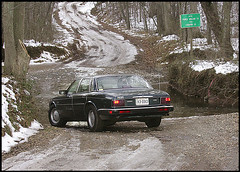How the center cities get dissed

Photographer: Tracy A. Woodward/Washington Post. Traffic along unpaved Braddock Rd and Peach Orchard Rd in Southern Loudoun County, VA. Commuting cars traveling along dirt roads (Braddock Rd and Peach Orchard Rd) in southern Louduon County. This is Ed Taylor, a realtor from Centreville, VA, cautiously driving his Jaguar on Peach Orchard Rd crossing Bull Run Stream. This is the dividing line as the sign says, Entering Prince William County leaving Loudoun County.
The region (hopefully) anchored by the center city is named after the center city, i.e., "Washington" or "Cleveland" or "Detroit."
This MSN real estate article, "30-city real-estate outlook," has this to say about "Washington":
Some prices don't start to bottom out until early 2010," he says. But in key markets where the rate of appreciation accelerated faster than household income growth — such as many cities in California and Florida, as well as Phoenix, Las Vegas and Washington, D.C. — he expects prices to drop by 20% or more.
But it is referring to the Washington Metropolitan Region, not to the Center City. DC proper is being painted with the broadbrush of housing declines that are particularly pronounced in the nether areas of the region.
Real estate is all about micro-markets. Commercial real estate brokers refer to submarkets, i.e., for the DC office market, Downtown is a submarket, so is NoMA, Dupont Circle, Union Station, M Street SE, etc. It works the same way for neighborhoods. And the real estate market in most DC neighborhoods is strong. (Of course it wasn't always this way.) So far.
Sure, top prices have declined. Stratospheric appreciation rates are less likely. Houses stay on the market longer. And there are foreclosure and short sale properties on the market. But fortunately, the real estate market in the center city of Washington, DC remains strong, even in the face of difficulties in outlying areas. And of course, other than the subprime meltdown specifically, part of the reason for weakness in the outlying markets in the region plays to the strengths of the center city: high gasoline prices in the region are countered by walkable neighborhoods served by transit and being relatively close to work in the core of the region, which will only increase (fuel) demand for center city property, and should work to strengthen the ability of the core of the region to retain businesses--although this may help Arlington County even more than DC. Who would have thought that the Navy's leaving Crystal City could actually lead to long term strengthening of the Crystal City submarket?

Rowhouses on 8th Street NE near Gallaudet University. Photo by Frozen Tropics.
Labels: economic development, real estate, real estate development



0 Comments:
Post a Comment
<< Home